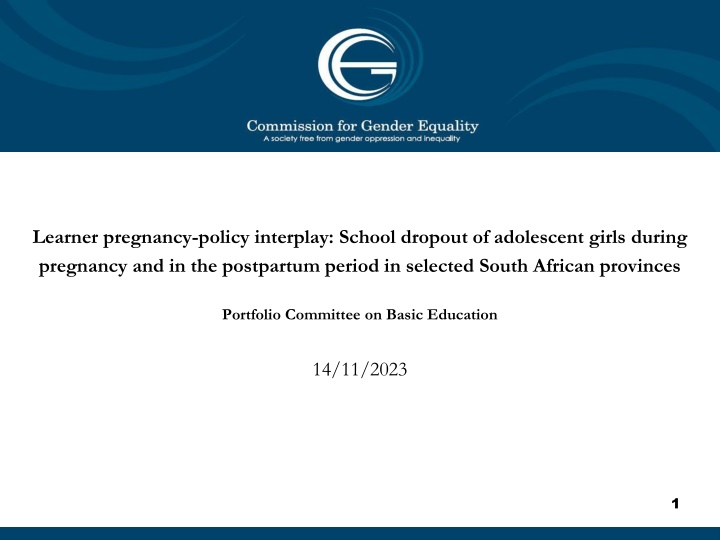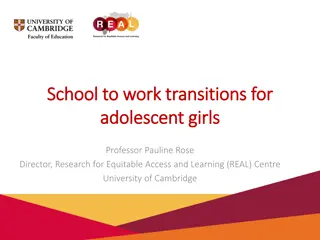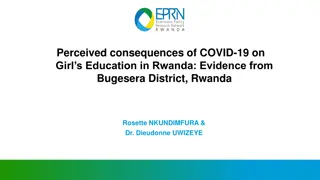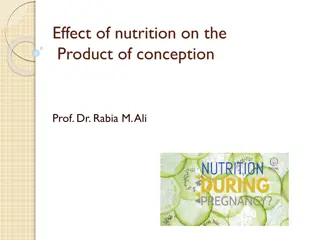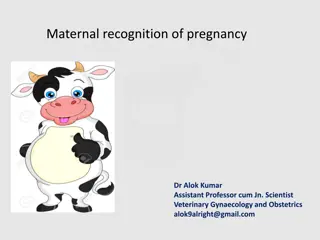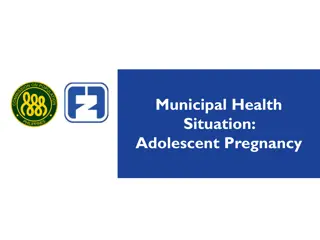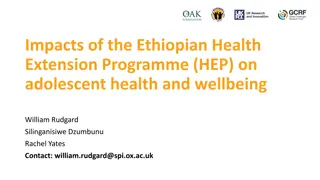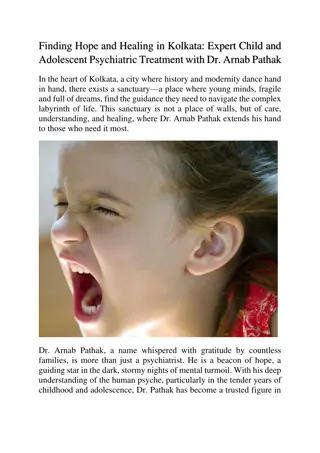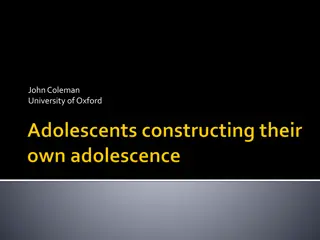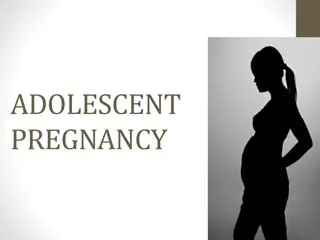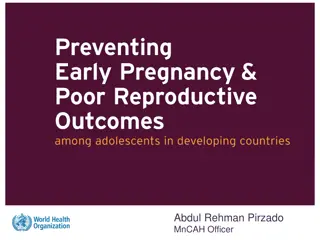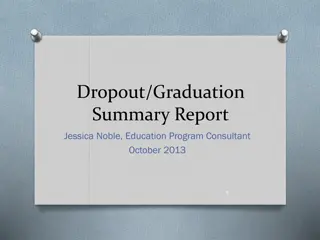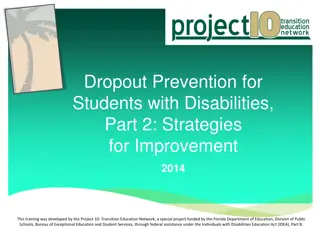Impact of Pregnancy on School Dropout Among Adolescent Girls in South Africa
This presentation explores the issue of school dropout among adolescent girls in South Africa due to pregnancy. It investigates the interplay between learner pregnancy policy and dropout rates, focusing on selected provinces. The study covers recruitment strategies, data collection methods, ethical considerations, research findings in different regions, and concludes with recommendations and the mandate of the Commission for Gender Equality. International and national legislative frameworks supporting the right to education for girls and women are also discussed.
Download Presentation

Please find below an Image/Link to download the presentation.
The content on the website is provided AS IS for your information and personal use only. It may not be sold, licensed, or shared on other websites without obtaining consent from the author.If you encounter any issues during the download, it is possible that the publisher has removed the file from their server.
You are allowed to download the files provided on this website for personal or commercial use, subject to the condition that they are used lawfully. All files are the property of their respective owners.
The content on the website is provided AS IS for your information and personal use only. It may not be sold, licensed, or shared on other websites without obtaining consent from the author.
E N D
Presentation Transcript
Learner pregnancy-policy interplay: School dropout of adolescent girls during pregnancy and in the postpartum period in selected South African provinces Portfolio Committee on Basic Education 14/11/2023 1
Structure of the presentation Recruitment strategy & sampling method Methods of data collection and research instrumentation Ethical Considerations Constraints and limitations of the study Research Findings: KwaZulu Natal Research Findings: Eastern Cape Research Findings: Limpopo Conclusion Recommendations CGE Mandate Introduction International Legislative Frameworks National Legislative Framework National Policy on the Prevention and Management of Learner Pregnancy Aim and Objectives of the Study Research approach & methods Research Methodology: Sampling Sampling: inclusion & exclusion criteria of the adolescents Key informants Population & 2
CGE Mandate The Commission for Gender Equality (CGE) is an independent statutory body established under Section 181 of the Constitution of South Africa. The mandate of the CGE is provided for in Section 187 of the Constitution and in the CGE Act No. 39 of 1996. The CGE has the power to monitor, investigate, research, educate, lobby, advise and report on issues concerning gender equality. The CGE is mandated to promote respect for, protect, develop and attain gender equality. The CGE makes recommendations on any legislation that has a bearing on gender issues. 3
Introduction A third of adolescent girls who become pregnant in South Africa return to school, with each year that passes after giving birth decreasing the chances of ever returning to school. Pregnancy is among the causes of school disruption, at secondary school level, and in many cases the birth of a baby marked the end of schooling for adolescent mothers. particularly, the More than 60% of pregnant teenagers did not return to school after the two-year period previously enforced by DBE (HSRC). 4
International Legislative Frameworks CEDAW (Article 10 guarantees the right to education for girls and women by placing an obligation on State parties to promote gender equality through the endowment of equal rights for men and women in education) Beijing Declaration and Platform for Action (The education and training of women form part of the 12 key areas for action entailed in the BPA) International Covenant on Economic, Social and Cultural Rights (Article 13 protects everyone s right to education at all levels and in all forms of education). MAPUTO PROTOCOL (Article 12 = Right to education. Calls for eliminating all forms of discrimination against women and requires member states to guarantee equal opportunity and access in the sphere of education and training) AFRICAN YOUTH CHARTER (Article 13 = member states are required to put measures in place to encourage regular school attendance and to address the challenge of school dropouts). AFRICAN CHARTER ON THE RIGHTS AND THE WELFARE OF THE CHILD (Article 11 guarantees the right to education for every child). 5
National Legislative Framework CONSTITUTION OF THE REPUBLIC OF SA (Section 29 of the Constitution of South Africa guarantees everyone the right to basic education). Promotion of Equality and Prevention of Unfair Discrimination Act (PEPUDA) (Its purpose is to give effect to Section 9 of the Constitution of South Africa, which provides for the enactment of national legislation to prevent or prohibit unfair discrimination and to promote the achievement of equality in the country. South African Schools Act - prohibits any unfair discrimination against learners in their admission to public schools. 6
National Policy on the Prevention and Management of Learner Pregnancy Approved by Cabinet in 2021, came into effect in January 2022 Responds to the 2012 Constitutional Court judgment against the DBE on their controversial 2007 measures for preventing and dealing with pregnancy among schoolgirls that subjected pregnant learners to a two-year ban from school post-delivery. Aims to prevent discrimination against pregnant learners and create an enabling and supportive environment for pregnant learners. Obligates teachers to report pregnancies of learners who are below 16 years as a result of a male person older than 16 to the South African Police Services (SAPS). 7
Aim and Objectives of the Study AIM: The study aimed to investigate reasons for school dropout by adolescent girls during pregnancy and in the postpartum period. It explored social, cultural, legislative, and economic factors that pose as barriers to school attendance by adolescent girls during pregnancy and after delivery. OBJECTIVES: To investigate factors that prohibit adolescent girls from returning to school during pregnancy and the postpartum period. To examine the effectiveness of current institutional, legislative, and other efforts to protect and promote the right to education and non-discrimination of pregnant learners and adolescent mothers. 8
Research approach & methods Used a qualitative research approach that enables the researchers to unearth a deeper understanding of people s behaviours, knowledge, views and subjective experiences. Adopted the phenomenological research design which is premised on the philosophy that the world is socially constructed. This design also aligns with the qualitative approach as it is also concerned with the meanings that people attach to their social realities. 9
Research Methodology: Population & Sampling Research Methodology: Population & Sampling Participants were from three provinces with the highest rates of teenage pregnancies in the country in 2019/20: KZN, Limpopo, and Eastern Cape. More than 83,000 children between the ages of 10 and 17 gave birth countrywide during the 2019/2020 financial year (Stats SA). KZN = 18,550 births, Limpopo = 13,129 births and Eastern Cape = 12,671. Study considered covering provinces with a high number of learner dropouts associated with pregnancies and childbirth, but accurate and reliable statistics that reflect these variables were not publicly available. Reasons given for dropping out of school differs by gender, especially for female learners who felt that they had to stop attending school due to family commitments (Stats SA, 2021). 13.4% of female learners dropped out of school due to the family commitments, which included getting married, minding children, and pregnancy.
Sampling: inclusion & exclusion criteria of the adolescents Sample size = 57 participants (24 adolescent girls and 33 key informants). Ages = 10 to 19. Adolescents must have dropped out of school while pregnant or after giving birth. Must have dropped out of school temporarily or permanently due to pregnancy or childbirth. Must have dropped out of school for at least six months to offer deep insights to enrich the study. Adolescents with a known history of mental illness were excluded as their participation could have prompted an increase or return of symptoms. Adolescents with a history of domestic or dating violence, rape, and sexual abuse were also excluded. 11
Key informants Senior officials from the National Department of Basic Education (2) School principals (4) Educators(8) Members of the school governing bodies (SGBs) (10) Members of the school management teams (SMTs) (8) Learner support agents (LSAs) (3) 12
Recruitment strategy & sampling method CGE Departments of Basic Education and their public schools to recruit adolescent girls and the key informants who fit the sampling criteria. Formal letters detailing these requests were written and sent to the provincial departments in EC, KZN & Limpopo, however, Limpopo did not co-operate. Snowball sampling was used given the hard-to-reach sample of adolescents. relied on the assistance of the Provincial 13
Methods of data collection and research instrumentation Individual face-to-face interviews used with adolescents and virtual interviews with the National DBE officials. Interviews tape-recorded with the knowledge and permission of participants, including parents and guardians in the case of adolescents under the age of 18. Interview guides for the various categories of study participants and key informants were developed and utilised to facilitate the semi- structured interviews. 14
Ethical Considerations Informed Consent Voluntary participation Confidentiality Anonymity Doing no harm 15
Constraints and limitations of the study Delays in getting responses confirming DBE s participation and collaboration with the CGE in the study. This was due to the sensitive nature of the study and having adolescents as participants. Delayed responses contributed to the research study taking longer than expected. Researchers experienced some uneasiness from the schools due to the data collection being done from October to December as this is exam time. The CGE had planned to conduct interviews much earlier, but couldn t due to the delays. Limpopo DBE was uncooperative and nonresponsive. Researchers wrote numerous emails, called multiple times, and physically went to the department to solicit cooperation, but in vain. Researchers then resorted to recruiting participants themselves. This was a significant limitation as the cooperation of the Limpopo DBE could have increased the sample size and contributed greatly towards enriching findings from the Province. 16
Research Findings: KwaZulu Natal The two KZN schools were in rural parts of Pietermaritzburg and Newcastle. The schools were under Quintiles 1 and 2. Lower quintile schools are either fully or partially funded by the DBE and are supported with scholar transport and feeding schemes. Factors leading to adolescent pregnancy and school dropout in KZN are listed in the next slides 17
KNOWLEDGE, ATTITUDE, AND PERCEPTIONS REGARDING ACCESS AND USE OF CONTRACEPTION SERVICES (KZN) Adolescents feared using contraception services provided through the mobile health clinics in schools. They preferred the fast-lane contraceptive option available at the local clinics, given the privacy or secrecy that this option presented. The fast-lane contraceptive option offered scholars the opportunity to bypass long queues at clinics. This afforded scholars the opportunity to return to school faster after receiving contraceptive services. DoH introduced the fast-lane approach to reduce the stigma and afford accessibility to adolescents to curb teenage pregnancy. Myths and misconceptions about contraceptive services existed among the adolescents interviewed. Religious norms and beliefs also came up as an impediment to accessing contraceptives. 18
LACK OF PARENTAL INVOLVEMENT AND SUPPORT (KZN) Participants (especially key informants) attributed the lack of parental involvement and support to adolescent pregnancy. Participants noted child-headed households, learners renting places of accommodation on their own, and learners residing with their grandmothers as indicators of potential lack of supervision and guidance from adults. The parents of most of the learners who were interviewed were migrant workers. This phenomenon could be attributed to the rife unemployment rate that persists in rural KZN. Working-class individuals tend to migrate to the cities to find employment. 19
ECONOMIC FACTORS (KZN) For adolescent girls who came from poor families, in a context of high unemployment, poverty and food insecurity, with few opportunities for income generation and a sustainable livelihood, transactional sexual relations appeared to be a legitimate means for attaining financial support. This meant that they were at risk of falling victim to unplanned pregnancies that result from these transactional sexual relations (often with men older than them) 20
INDIVIDUAL FACTORS (KZN) Based on literature, adolescent pregnancy may result in feelings of shame and guilt, leading to a momentary or even permanent delay in pregnant learners dreams. Not all adolescents may feel adequately prepared psychologically to return to school after birth and do well academically, leading to school dropouts. This extract from one of the participants illustrates this point: I lost myself. I even considered going to a TVET college because I fear facing people who made fun of me at school for leaving my previous school and coming here only to have another child. I was depressed and I had suicidal thoughts, especially after my second baby. I ran away to live with my uncle, whom I knew would not have much to say and [not] judge me . 21
HOUSEHOLD FACTORS (KZN) When an adolescent mother s financial status does allow for a childminder, cr che, or medical challenges or disabilities arise in the child of an adolescent mother, there is a high chance that the learner will not return to school. Therefore, household circumstances play an integral role in the learner deciding whether to return to school. An adolescent mother expressed the following: Sisi, I am just waiting for my child to be two years so that I can leave her with my grandmother. My grandmother cannot stay with my child while very little. My mom is working in Durban and cannot afford me and my child . Experiences expressed by a young mother: I am hurt that the father of my child is carrying on with school. I am stuck here with my child. I tried negotiating for my baby boy to stay with his father s family. At least my child s paternal grandfather is around but my boyfriend s mother refused. My mom suggested I find work because she says I am a woman now with responsibilities. She wants me to feed my child . 22
KNOWLEDGE OF RELEVANT LEGISLATION AND POLICIES ON HANDLING LEARNER PREGNANCY AND THE RETENTION OF LEARNERS IN SCHOOL (KZN) The school principals from both schools indicated that knowledge- sharing and awareness-creation sessions about the National Policy on the Prevention and Management of Learner Pregnancy were conducted through several meetings. In contrast, findings from interviews with educators, SGB members, and adolescent mothers illustrated a lack of knowledge of the policy. 23
TRAINING AND CAPACITY BUILDING (KZN) Training and capacity building on the policy regulating the handling of pregnant learners and retention of the learners in school is important, as it would ensure the standardisation of practices within schools. Capacity building would also ensure that correct procedures are followed in handling this sensitive matter of the retention of pregnant learners and adolescent mothers in school. Another imperative for training and capacity building on policy is that the National Policy on the Prevention and Management of Learner Pregnancy specifies roles for the various stakeholders involved in handling pregnant learners and adolescent mothers in schools. Without the necessary training, these role players could thus be unwittingly executing their roles incorrectly. It must be noted, however, that a senior official from the national DBE highlighted during a research interview that the rollout of training on the policy had not been covered in the whole country. 24
APPLICATION OF LEGISLATION, POLICY, AND PRACTICES BY SCHOOLS (KZN) There were no standardised practices in place for handling pregnant learners and their retention in school. This largely stemmed from the lack of knowledge and training on the National Policy on the Prevention and Management of Learner Pregnancy among key stakeholders. A 19 year-old adolescent mother in grade 12 reported that the school had denied her the opportunity to return to school based on a falsified narrative that she was over the age of admission. She explained that six months after she gave birth, her grandmother attempted to get her back to school but the school refused until the intervened and she was readmitted as the school s refusal was discriminatory. 25
APPLICATION OF LEGISLATION, POLICY, AND PRACTICES BY SCHOOLS (KZN) The support of learners was also inconsistent and reliant on the benevolence of teachers. It was revealed that it was not standard practice for schools to provide academic support to pregnant learners and adolescent mothers. Instead, the support depended on the willingness of teachers. School officials revealed that learners went to great lengths to conceal pregnancies, which in return led to late discoveries by the school with very little opportunity to provide support. 26
RESEARCH FINDINGS: EASTERN CAPE In 2019/2020, the Eastern Cape reported 12,671 live births among adolescents, consequently assuming the third position of the highest live births among adolescents aged 10 to 17. For confidentiality and anonymity reasons, the four schools visited in the Eastern Cape are referred to as Schools A, B, C, and D. All the schools were situated in rural areas, and at least three of them (Schools A, B, and D) experienced mobile network issues that affected their ability to communicate with the outside world or call for assistance when needed. 27
KNOWLEDGE, ACCESS, AND USE OF CONTRACEPTION SERVICES (EC) Many factors influence this phenomenon, and one of the school principals interviewed in the study shared the following in relation to this: The Department of Health assisted us with giving contraception, but parents said they do not want their children to be given contraception. They believe that it will make their children barren and all those kinds of things. The Department of Health started coming less because of this. I think that s why our pregnancy rate has increased. An SGB member from one of the schools noted peer pressure as one of the reasons for teenage pregnancy in her school. She further recalled conversations with learners where they expressed concerns over contraceptives making their bodies wobbly . 28
KNOWLEDGE, ACCESS, AND USE OF CONTRACEPTION SERVICES (EC) Reasons for low contraceptive uptake by adolescents included them not knowing why they did not use contraceptives when they first started having sex.One learner said that condom use was discussed briefly in her relationship but never practiced.Another learner admitted to using contraceptives inconsistently,while another said she only started using contraceptives after she had her baby. Arguably, another reason for low contraception use among adolescents in the four Eastern Cape schools could be attributed to the long distance between clinics and learners places of residence.In this regard, one learner said, it s very far from where I stay. It costs me R22 or R23 to go there. The clinic used to come to my school, but it s been a while now since they ve been there . School officials from the various schools also shared that in addition to Life Orientation classes, awareness raising regarding teenage pregnancy, contraception use, and crime takes place in the schools.This was done in partnership with the DoH, DSD, and SAPS. 29
MINIMUM OR LACK OF PARENTAL INVOLVEMENT AND SUPPORT (EC) School officials interviewed in the sampled schools in the Eastern Cape revealed that learners came from child-headed homes. Some lived with their grandmothers or single mothers. Others lived alone in rented accommodation to be closer to the schools. A minority of learners were reported to be living with both their mothers and fathers. One adolescent girl shared the following experience in relation to her strained relationship with her mother: I lost my child. It s hard because when my mom and I argue she brings up the fact that I got pregnant while at school and I gave birth to a baby that didn t even survive. That affects me and it affected my relationship with my mom. I am no longer staying with her right now. I stay with my stepmom . 30
ECONOMIC FACTORS (EC) Poverty as a factor that drives adolescent pregnancy came up several times during interviews. Principals, educators, SMT and SGB members, and LSAs cited poverty as a factor. An LSA at one of the schools expressed that most learners came from disadvantaged backgrounds, and when they fall pregnant, there is always the fear and perception that they are worsening their situation. Controversially and unproven, one of the school principals and an SMT member described adolescent pregnancy as a means to access the childcare grant. An SGB member explained that learners were already surviving on social grants and this was not enough to sufficiently support them & their families. 31
CULTURAL NORMS AND BELIEFS (EC) Traditional embedded in the cultural practices, norms, and beliefs of the Xhosa people, as well as other tribes. An SMT member was of the opinion that boys often came back from initiation schools with the desire to prove their manhood through sexual activity & and this often led to unplanned pregnancies. male initiation/circumcision is 32
SUBSTANCE ABUSE (EC) Substance abuse was another factor believed to play a role in the extent of adolescent pregnancy in the Eastern Cape schools visited by researchers. An educator in one of the schools shared that the school experienced an alcohol consumption problem among learners and this could lead to reckless behaviour by learners. school, another educator said, they also drink alcohol and it s concerning because when they are drunk, they can be taken advantage of easily . From interviews, researchers found that School A even had a groundsman who monitors school grounds and toilets because learners are said to be drinking and smoking marijuana at school. Referring to female learners in her 33
STATUTORY RAPE, DATING OLDER MEN AND TEACHER-LEARNER SEXUAL RELATIONS (EC) School officials communicated that learners were having relationships with other learners within the same schools. However, they were also dating other learners from other schools. One educator shared the following: What I see in our school is that a Grade 12 learner will be dating a Grade 8, 9, or 10 learner. Grade 12s here don t seem to like dating amongst each other. So, there s a three-year age gap between them. It does happen that a 14-year-old falls pregnant, but we hardly ever get involved unless the parent comes to lay a complaint. I understand that abuse may have occurred in such instances, but I don t know the procedures that need to be taken . The current National Policy on the Prevention and Management of Learner Pregnancy compels educators to report learner pregnancies of children under the age of 16 by males older than 16 years to the SAPS. However, the extract above shows that the educator was unaware of the steps to take with such matters. 34
STATUTORY RAPE, DATING OLDER MEN AND TEACHER-LEARNER SEXUAL RELATIONS (EC) School officials interviewed in School A shared that they understood their responsibility to report incidents of adolescent learners under the age of 16 being impregnated by males older than 16. However, they found it difficult to penetrate the secrecy surrounding the identity of fathers as engaging pregnant learners and their parents proved futile. In this regard, an SGB member shared that: Remember when the man is much older there would be financial benefits that the pregnant learner is getting, so, they would hide the man s age from us because if they tell us they might lose those benefits. As a teacher the benefits they will be getting will be irrelevant to me, I will just look at the age gap and see that its child abuse . 35
STATUTORY RAPE, DATING OLDER MEN AND TEACHER-LEARNER SEXUAL RELATIONS (EC) Concerning information was also shared about teacher-learner sexual relations. An SMT member shared that: We once heard that a teacher was dating a learner years back. When we asked the learner, she denied this. Community members would see the teacher fetch the child from her home with his car, but the learner refused to tell us the truth. So, I do ask them, but I don t believe the answers they give me . An educator revealed the following about her school: We had rumours here once of a teacher who was dating students. Another one said she was impregnated by a teacher s assistant, but I don t know where that case ended up. Another learner also reported a teacher for sexual advances heing made towards her, this was a while ago and it was handled by our previous principal. That teacher s contract was terminated after the case was finalised and he was an SGB member from the teacher component . It is important to highlight that female educators are not exempt from this problem, they too must abide by the law & not have any sexual relations with learners. 36
INAPPROPRIATE SEXUAL CONDUCT BY LEARNERS (EC) Two different school officials in one school shared concerning incidents of learners having sex with each other on school grounds. To them, this pointed to early sexual debut which could lead to early and unplanned pregnancies. 37
HOUSEHOLD-RELATED FACTORS (EC) A few school officials interviewed in the study mentioned the socio- economic statuses of families, parental involvement, and support issues as part of the reasons why some learners drop out of school during pregnancy and post-delivery. Adolescent mothers who opted to dropout of school often did not have anyone at home to look after the baby. One participant shared that she had also resigned herself to having to dropout of school until her older sister offered to look after the baby. In other cases educators shared that they often had to plead with parents to make a plan about child care in order to allow adolescent mothers to return to school. 38
SCHOOL-RELATED FACTORS (EC) Pregnant learners who considered dropping out and those who dropped out expressed that most of the time, educators did not discriminate against or ridicule them for being pregnant or being mothers. An SMT member who was also an educator felt that his fellow educators and himself could do better in terms of being more supportive toward pregnant learners and adolescent mothers instead of judging them. Some school officials felt that pregnancy in their schools was so common that learners viewed it as normal, which then meant that they would not discriminate against each other because of it. On the contrary, other school officials noted that learners mocked each other and sometimes even reported each other to educators for this, but this was viewed as normal childlike behaviour that did not warrant serious intervention. 39
SCHOOL-RELATED FACTORS (EC) Researchers noted the lack of academic and psychosocial support systems during data collection at the Eastern Cape schools. In terms of psychological support for pregnant learners and adolescent mothers, schools relied on their LSA (if they have one) or their local social workers. However, another senior DBE official interviewed in the study noted that LSA positions only had a minimum requirement of a Grade 12 certificate, meaning that LSAs were not professionals in psychosocial support provision. Hence, their role was solely linking learners with healthcare and other support services. The senior DBE official further noted that LSAs have basic training in psychosocial support services. However, they are always cautioned not to delve too deeply when learners present with psychosocial issues because they do not have the proper skills to handle those issues correctly. 40
KNOWLEDGE OF RELEVANT LEGISLATION AND POLICIES ON HANDLING LEARNER PREGNANCY AND THE RETENTION OF LEARNERS IN SCHOOL (EC) School officials were asked to detail their knowledge of the National Policy on the Prevention and Management of Learner Pregnancy approved by the Cabinet in 2021. In School A, school officials were aware of the policy and were able to give accurate synopses of it. School officials shared that senior officials from the Eastern Cape DBE went to the school and explained the policy after recognizing that school officials had little to no knowledge of it. School officials in School B had no knowledge of the policy. According to them, the DBE had not informed them about a new policy or sensitized them to it. A school official interviewed in School C said she did not recall anyone from the DBE visiting the school to make staff aware of the new policy. Only learners were interviewed in School D, and none were aware of the policy. In fact, all learners interviewed in the Eastern Cape did not know about the new policy. 41
TRAINING AND CAPACITY BUILDING (EC) School officials from all the schools visited in the Eastern Cape received no training or capacity building to assist them in handling pregnant learners or the problem of adolescent pregnancy in schools and related school dropouts. The LSA interviewed in one of the schools explained that LSAs were trained by the DBE on how to identify and assist vulnerable learners. However, training and capacity building specific to pregnant learners and their needs was not offered. 42
APPLICATION OF LEGISLATION, POLICY, AND PRACTICES BY SCHOOLS (EC) The schools visited in the EC had their own pregnancy strategies or practices that required seven-month pregnant learners to be accompanied to school daily and guarded by a parent or a caretaker in case they went into labour or had any pregnancy-related complications.When asked how these strategies & practices came about, officials from School A explained that it resulted from pregnancy-related incidents in the school, i.e. 2 pregnant learners giving birth at the school and others having to be rushed to hospitals at the onset of labour or other complications. School officials also explained their uneasiness about having to use their own resources (such as cars) to transport pregnant learners in labour or suffering complications to the clinic or hospital. The need for transport is a result of the school being in a rural area that struggles with cell phone coverage, therefore, hindering school officials from calling for help. In addition, the interviews revealed that the local clinics are not equipped to deal with childbirth. The hospitals are far, and an ambulances often take a long to reach schools. School officials also felt inadequate with regard to pregnancy and childbirth emergencies. They were worried about being blamed or held liable if something went wrong while trying to assist a pregnant learner in an emergency. 43
APPLICATION OF LEGISLATION, POLICY, AND PRACTICES BY SCHOOLS (EC) School officials from school A explained that since the policy briefing by senior officials from the district DBE office in the Eastern Cape, pregnant learners are no longer required to be accompanied by a parent or caretaker from the seventh month of pregnancy. However, the school officials bemoaned the secrecy that often surrounds pregnancies in the school, with learners reporting that their parents instruct them not to inform the school about the pregnancy but to let teachers see for themselves . At the time of data collection, the pregnancy strategy was applied in the other three sampled schools. This was somewhat expected as school officials had expressed no knowledge of the National Policy on Prevention and Management of Learner Pregnancy. 44
APPLICATION OF LEGISLATION, POLICY, AND PRACTICES BY SCHOOLS (EC) There is someone who deals with pregnant learners at my school, so she came to ask me if I was pregnant. And I said yes and then she took me and another girl who was also pregnant to the principal. I was six months pregnant, and the principal and another teacher told me that I need a parent or a caretaker from seven months. I was told not to come to school if I didn t have a caretaker . The learner further explained that she lived with her grandmother, who said she could not accompany her to school or afford to hire a person, leading to the learner dropping out of school mid 2022. The learner also shared that another fellow learner who also fell pregnant dropped out of school because the school would not allow her to bring her father to play the caretaker role because according to the principal men know nothing about pregnancy and can t assist if complications arise . A learner who had dropped out of school shared the following: 45
RESEARCH FINDINGS: LIMPOPO Limpopo was ranked second on the list of provinces with the highest number of births recorded among children ages ten to 17 in the 2019/2020 financial year. The total stood at 13,129, which only covers the estimated number of births and not the actual number of pregnancies in the province. Although the province had a low dropout rate of 800, taking the eighth place of the nine provinces in 2020/2021, Limpopo had the largest number of learners in the country who repeated Grades 8 to 11, as well as the lowest matric pass rate overall in the country at 66.7% in 2022/2023. The province is predominantly rural, with over 80% of the population living in rural areas. Public schools in the province have continuously faced challenges of poor infrastructure, poor parental involvement, and a general lack of resources. Knowledge and use of contraceptives are reportedly low among adolescents in the province, with a study illustrating that 29% of female adolescents had experienced sexual debut before the age of 14.287 46
KNOWLEDGE, ACCESS, AND USE OF CONTRACEPTION SERVICES (L) All four participants had some form of knowledge of the various types of contraceptives but displayed very little understanding of how they work. The most common types of contraceptives known to the participants were the contraceptive injection, contraceptive pills, and contraceptive implants. It is also worth noting that none of them had used contraceptives prior to falling pregnant. In addition to limited knowledge of contraceptives and how they work, the participants reluctance to take up contraceptives was also influenced by biological misconceptions and myths regarding the side effects of contraceptives. Participants expressed fear of being stigmatised and the preconceived healthcare workers negative attitudes as a barrier. The data obtained from the interviews revealed that these fears were influenced by friends interactions with healthcare workers, given that they did not have first-hand personal experiences with healthcare facilities prior to falling pregnant. 47
LACK OF PARENTAL INVOLVEMENT (L) The findings of the study revealed that the topic of sex was taboo in most households. All four participants interviewed in Limpopo had come from female-headed households, with three headed by the participants biological mothers and one by the maternal grandmother. One of the participants had the following to say on this matter: I don t remember us [the participant and her mother] ever discussing sex or boys. I personally don t care much about the sex topic, but I wish we could discuss boys, like how they change after pregnancy just to let my mother know how I feel. But I ve always been afraid of her. She does not seem like the type of person anyone can talk to about such. She would actually shout at me like even after I started dating my baby daddy [father of the child], I wanted to talk to my mother about it, to get advice and all that. But I was scared she would shout at me and tell me to focus on my studies. That s the one thing she has always emphasised to me, to focus on my books and not even look at boys . 48
LACK OF PARENTAL INVOLVEMENT (L) One of the parents adopted an abstinence-only approach taught through a moralistic injunction. One of the dangers that parents seemed oblivious to concerning the avoidance of sex talk , however, was how it laid fertile ground for older men to prey on and begin sexual relationships with their children in secret. All four adolescents who participated in this study in Limpopo had been impregnated by older men whose ages ranged from 24 to 30, in contrast with the adolescent s ages of 16, and three who were 17 years old when they fell pregnant. Although the adolescents were 16 and 17 years old, which means they were of consenting age when they fell pregnant, it should be noted that three of them had had their first sexual encounters at ages below sixteen. 49
INDIVIDUAL FACTORS (L) The interviews revealed that individual factors, such as adolescents self-esteem and motivation, played a role in determining the prospect of retention in school during pregnancy and after the birth of their children. One of the participants had the following to say: The reason why I dropped out from school is because I was just shy and scared of being turned into a laughingstock. Er! I didn t like the fact that people would turn me into a laughingstock they laughed at me because the father of my child had turned his back on me. He was absent I then decided to quit school . Because of school interruptions due to ill health and the time taken off for maternity leave, some adolescent girls experience discouragement from continuing with their education. 50
